Gastrointestinal disorders: natural and effective treatment
Gastric complaints are a widespread health problem. Especially with advancing age, many people are affected by this. Our digestive tract is a very complex system and it has to cope with many tasks – therefore is easy to get out of balance. This has a huge impact on our well-being because our entire health depends on its functioning.
The good news is that you can support your stomach and intestines very well with medicinal mushrooms. Medicinal mushrooms have a preventive effect, but have also proven their worth in the treatment of various gastrointestinal diseases.
Which symptoms indicate a gastrointestinal disease?
Have you noticed any changes in your digestion lately? Do you perhaps suffer more frequently from flatulence or bloating? Which symptoms are actually indications of a gastrointestinal disorder? This question is not easy to answer. The human digestive tract is a complex system and is connected to many organs and even the brain. So if you suffer from symptoms such as diarrhoea, constipation, blood in the stool, abdominal pain, heartburn, but also tiredness, depressed mood and exhaustion, you should take a close look at your gastrointestinal tract.
From the plate to the stomach
Our digestive tract is divided into different departments. The digestive process is prepared in the mind: When you see a dish in front of you, your brain already passes on information about it to the digestive tract. You notice that your mouth is watering.
 When you bring the fork to your mouth, the first digestive process takes place. You crush the food with your teeth and mix it with saliva to form a pulp. The digestion of complex carbohydrates already begins in the mouth. We notice this because if we chew a piece of bread long enough, a sweet taste is created by the glucose, the product of cleavage. From the mouth, the food pulp passes through the oesophagus into the stomach. The transition to the stomach is controlled by the so-called oesophageal sphincter, a ring muscle. It ensures that predigested stomach contents cannot get back into the oesophagus.
When you bring the fork to your mouth, the first digestive process takes place. You crush the food with your teeth and mix it with saliva to form a pulp. The digestion of complex carbohydrates already begins in the mouth. We notice this because if we chew a piece of bread long enough, a sweet taste is created by the glucose, the product of cleavage. From the mouth, the food pulp passes through the oesophagus into the stomach. The transition to the stomach is controlled by the so-called oesophageal sphincter, a ring muscle. It ensures that predigested stomach contents cannot get back into the oesophagus.
From the stomach onwards, the digestive processes become complex. In the following, we will explain the individual stations of digestion in more detail.
The stomach
The stomach muscles ensure optimal mixing of the food pulp with the digestive juices released. First of all, the production and secretion of gastric acid is important for the digestion process. The gastric acid is produced and secreted by the gastric acid cells in the stomach wall. 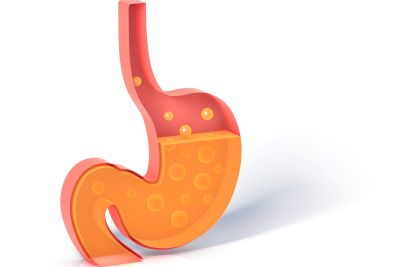 The gastric acid is hydrochloric acid, which has a very low pH value. In this very acidic environment, the proteins ingested with food are prepared for digestion, they are denatured. For protein digestion, the main cells release precursors of protein-splitting enzymes, pepsinogen, into the stomach contents. The hydrochloric acid activates the pepsinogen to the active enzyme pepsin. This immediately begins to break down proteins in the food. In principle, pepsin would not stop at the stomach wall. However, a protective coating of mucus on the inner wall prevents the stomach from digesting itself in this way. This protective mucus is formed by the stomach’s accessory cells. However, the task of the stomach acid is also to kill germs that enter the stomach with the food and to transport them further with the help of the mucus and ultimately to excrete them with the stool.
The gastric acid is hydrochloric acid, which has a very low pH value. In this very acidic environment, the proteins ingested with food are prepared for digestion, they are denatured. For protein digestion, the main cells release precursors of protein-splitting enzymes, pepsinogen, into the stomach contents. The hydrochloric acid activates the pepsinogen to the active enzyme pepsin. This immediately begins to break down proteins in the food. In principle, pepsin would not stop at the stomach wall. However, a protective coating of mucus on the inner wall prevents the stomach from digesting itself in this way. This protective mucus is formed by the stomach’s accessory cells. However, the task of the stomach acid is also to kill germs that enter the stomach with the food and to transport them further with the help of the mucus and ultimately to excrete them with the stool.
The follicular cells not only produce hydrochloric acid, but also the alkaline sodium bicarbonate. Acid and base production are therefore directly related to each other. However, the sodium bicarbonate is passed on via the bloodstream to basophilic organs such as the liver, pancreas and the gastric mucus-forming accessory cells.
The intestine
The intestine is not only the central place of digestion, it is also an important pillar of our health. 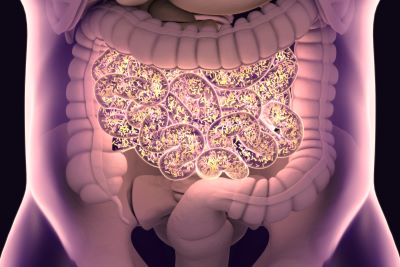 It is closely connected to the immune system and the psyche. This means that a susceptibility to infections or depression can be caused by a disturbance of the intestinal environment. Unfortunately, initial symptoms of a disorder or illness are often difficult to assign. Fortunately, vital mushrooms and other natural remedies help against heartburn, constipation, flatulence, abdominal pain as well as other dysfunctions without producing side effects.
It is closely connected to the immune system and the psyche. This means that a susceptibility to infections or depression can be caused by a disturbance of the intestinal environment. Unfortunately, initial symptoms of a disorder or illness are often difficult to assign. Fortunately, vital mushrooms and other natural remedies help against heartburn, constipation, flatulence, abdominal pain as well as other dysfunctions without producing side effects.
Small and large intestine
Anatomists divide the intestine into two large sections: the small intestine and the large intestine. The names refer to the diameter of these intestinal sections. While the small intestine connects directly to the stomach and reaches up to five metres in length, the large intestine forms the last part of the intestine.
The small intestine consists of the twelve-finger intestine, the jejunum and the ileum. The main task of the small intestine is to break down food into smaller and smaller components, which are ultimately absorbed by the mucous membrane of the small intestine. From there, the nutrients enter the blood. Because the process of thorough breakdown takes a long time, the small intestine is so long. Various digestive juices such as saliva, gastric juice, bile, pancreatic and small intestinal secretions are involved in the digestion process. For a larger absorption surface, the inner wall of the small intestine is covered with folds and protrusions, resulting in a total of about 200 square metres of mucosal surface. Vital mushrooms are a good way to care for this sensitive mucous membrane.
The large intestine reaches a length of about one and a half metres. It begins with the appendix, where the appendix is located. This is followed by the ascending, transverse and descending branches of the colon. This is followed by an S-shaped bend called the sigmoid. The rectum forms the last section and finally ends in the anus. The main task of the colon is to thicken the stool. To do this, the mucous membrane absorbs water and electrolytes dissolved in it. The stool collects in the rectum until the excretory reflex is triggered.
The twelve-fingered intestine
The twelve-finger intestine is an important section of the small intestine and has a lot of work to do. When the acidic food pulp from the stomach reaches the twelve-finger intestine, it is essential to raise its pH value. This is done primarily by the very alkaline digestive juice of the pancreas and additionally by the bile juices produced in the liver. 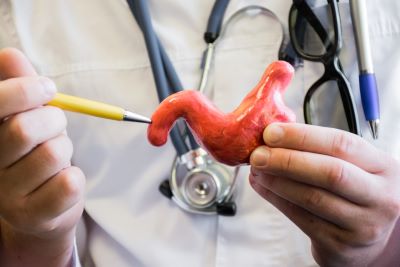 The secretion of the pancreas contains bicarbonate: it neutralises the acidified food pulp in the stomach because otherwise the enzymes in the small intestine could not work. These enzymes are also supplied by the pancreas. They are amylases for carbohydrate digestion, proteases for protein breakdown and lipases for fat cleavage. They enter the small intestine as inactive precursors and are only activated there. Before the lipases can do their work, the dietary fats must first be finely distributed as fat droplets in the aqueous milieu of the small intestine. The bile acids contained in the bile emulsify the fats and thus make the cleavage by the pancreatic lipases possible.
The secretion of the pancreas contains bicarbonate: it neutralises the acidified food pulp in the stomach because otherwise the enzymes in the small intestine could not work. These enzymes are also supplied by the pancreas. They are amylases for carbohydrate digestion, proteases for protein breakdown and lipases for fat cleavage. They enter the small intestine as inactive precursors and are only activated there. Before the lipases can do their work, the dietary fats must first be finely distributed as fat droplets in the aqueous milieu of the small intestine. The bile acids contained in the bile emulsify the fats and thus make the cleavage by the pancreatic lipases possible.
The intestinal mucosa
The mucous membrane in the small and large intestine is essential for functioning digestion. It ensures that only the necessary nutrients and water enter the body. It keeps all other substances and pathogens from entering. The mucosa itself consists of mucosal cells that are connected to each other by ribbon-like proteins (tight junctions). Without these connections, undigested substances and pathogens can slip between the mucosal cells.
Headquarters of the immune system
Our defences are directly related to our gut health because the gut is home to around 80% of our immune system, the so-called gut-associated immune system. Likewise, all mucous membranes in the body depend on the health of the intestinal mucosa. The so-called “mucosal pathway” connects all mucous membranes with each other. That is why, for example, an infection of the mucous membrane in the nose and throat area is easier to treat if the intestinal health is promoted at the same time.
The intestinal environment
The environment of our digestive tract is largely determined by a large number of bacteria that colonise the gastrointestinal tract. This is also referred to as the physiological intestinal flora or microbiota. They live in a symbiosis, i.e. a symbiotic community with our organism. Experts speak of around 160 different species of bacteria. Significantly more bacteria live in the large intestine than in the small intestine. Besides digestion and the synthesis of vitamins and amino acids, their task is to defend us against pathogens. In addition, the bacteria strengthen the immune system through constant training. They nourish the intestinal mucosa by supplying it with short-chain fatty acids. If the intestinal environment is out of balance, the door is wide open to various health problems such as irritable bowel syndrome, metabolic syndrome, diabetes, chronic inflammatory bowel diseases, rheumatoid arthritis and also cardiovascular diseases and neurological disorders. Prebiotics support the intestinal flora. For example, the long-chain carbohydrates (polysaccharides) from vital mushrooms have a prebiotic effect.
The gut-brain axis
The intestine and brain are in constant exchange with each other. The intestine is surrounded by a good 100 million nerve cells. 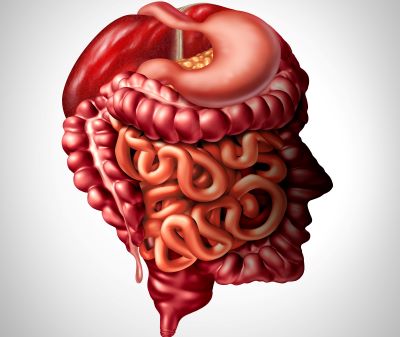 Close contact between the brain and the intestines is important, among other things, for a balance between the nutrients we take in and the nutrients we need. Ideally, this gives us an appetite for exactly those things that contain the nutrients we lack. Furthermore, it is important to regulate the various circuits that are involved in the transport of food. To do this, the brain must maintain the balance between inhibitory (serotonin) and excitatory nerve messengers (noradrenaline). 95 % of serotonin is produced in the intestine itself. This “happiness hormone” has a mood-lifting, relaxing and appetite-regulating effect. Directly in the intestine, it regulates secretion and resorption processes. It also determines the perception of pain. People with irritable bowel syndrome often have low serotonin levels.
Close contact between the brain and the intestines is important, among other things, for a balance between the nutrients we take in and the nutrients we need. Ideally, this gives us an appetite for exactly those things that contain the nutrients we lack. Furthermore, it is important to regulate the various circuits that are involved in the transport of food. To do this, the brain must maintain the balance between inhibitory (serotonin) and excitatory nerve messengers (noradrenaline). 95 % of serotonin is produced in the intestine itself. This “happiness hormone” has a mood-lifting, relaxing and appetite-regulating effect. Directly in the intestine, it regulates secretion and resorption processes. It also determines the perception of pain. People with irritable bowel syndrome often have low serotonin levels.
Due to the close cooperation of the intestine with the nervous system, it reacts particularly sensitively to stress: an overactivity of the sympathetic system or a dysfunction of the parasympathetic system have a direct effect on digestion. Symptoms can be “stomach rumbling”, sudden urgent bowel movements or diarrhoea. In the long term, diseases such as irritable bowel syndrome or irritable stomach syndrome can develop. This is where vital mushrooms come in. On the one hand, they have a calming and balancing effect on the nervous system and, on the other, they improve digestion and the intestinal environment.
What are the gastrointestinal diseases?
As you have now seen, our digestive system is complex and closely connected to other areas of the body. Unfortunately, this complexity also brings with it a multitude of possibilities for illness. Here we present an overview of the most common gastrointestinal diseases and their causes.
The leaky gut syndrome
The English term “leaky gut” means something like “leaking intestine”. In this disease, the intestinal mucosa has small holes so that the natural barrier is no longer guaranteed. This problem occurs mainly in the area of the small intestine, where incompletely digested food components, allergens and toxins, among other things, can then enter the body directly. The weakened barrier and defective tight junctions are accompanied by a thin mucus layer, a low sIg A level and a disturbed intestinal flora. Inflammation develops, which further promotes the leakage. Now the immune system kicks in and takes action against the unwanted invaders. This is often the beginning of food allergies. Sometimes the substances that invade the organism resemble the body’s own tissue structures. As a result, the immune system attacks the corresponding tissue. This is how autoimmune diseases develop.
The causes of leaky gut are manifold and not conclusively clarified. It is probably always an interaction of various unfavourable factors such as:
– poor diet with lots of simple carbohydrates, little fibre and lots of bad fats and alcohol
– Medication, e.g. antibiotics, non-steroidal anti-inflammatory drugs, cortisone
– Radiation and chemotherapy
– Candida infestation
– prolonged stress
– Vital substance deficiency, especially vitamin A and zinc
– Infections in the gastrointestinal tract
– Food intolerances
Leaky gut syndrome is often the undiscovered cause of other diseases, some of which are considered incurable. The connection with a disorder of intestinal function is often not obvious:
- Allergies, food intolerances
- Asthma
- Autoimmune diseases
- Neurodermatitis and other skin diseases
- Cardiovascular diseases
- Multiple sclerosis
- Ankylosing spondylitis
- Chronic fatigue syndrome
- Migraine/headache
The good news is that leaky gut can be treated well with natural remedies such as medicinal mushrooms. So an improvement of the secondary disease is also likely.
Irritable stomach
Irritable stomach is a diagnosis of exclusion. 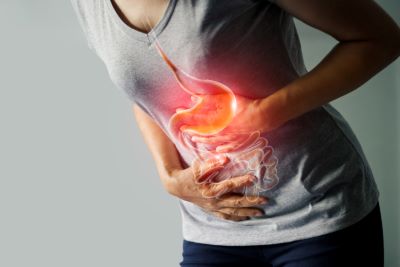 This means that this diagnosis is made when all other possible causes have been ruled out. Complaints include a feeling of fullness to a feeling of pressure in the upper abdomen, belching, nausea, vomiting with vegetative symptoms such as rapid heartbeat and heavy sweating. The exact cause is unclear. Experts assume that those affected are hypersensitive. In addition, examinations often reveal psychological stress in patients as well as a history of other gastrointestinal diseases. An unhealthy lifestyle and poor nutrition aggravate the problem.
This means that this diagnosis is made when all other possible causes have been ruled out. Complaints include a feeling of fullness to a feeling of pressure in the upper abdomen, belching, nausea, vomiting with vegetative symptoms such as rapid heartbeat and heavy sweating. The exact cause is unclear. Experts assume that those affected are hypersensitive. In addition, examinations often reveal psychological stress in patients as well as a history of other gastrointestinal diseases. An unhealthy lifestyle and poor nutrition aggravate the problem.
Irritable bowel
Irritable bowel syndrome often occurs together with irritable stomach syndrome. This diagnosis is also made by the doctor when other clinical pictures can be ruled out. Indications of irritable bowel syndrome can be prolonged abdominal pain with flatulence, constipation or diarrhoea. Persistent fatigue and negative moods also occur in this context.
Gastritis
Gastritis is an inflammation of the stomach lining. The acute form is usually accompanied by upper abdominal pain, nausea and belching. The three chronic forms, which can be asymptomatic for a long time, are to be distinguished from this. When making a diagnosis, all types are characterised by a damaged or at least weak stomach lining and too much or too little gastric acid.
Possible treatment depends on the type of gastritis and thus on the causes. For example, acute gastritis is often caused by stress, food poisoning, the use of certain medications or an infection. Consuming a lot of coffee, alcohol, nicotine and spicy food can also attack the stomach lining. In alternative medicine, vital mushrooms such as Reishi and Hericium have proven to be effective anti-inflammatories.
Type A chronic gastritis, on the other hand, is an autoimmune disease in which the immune system destroys the stomach cells. As a result, acid production in the stomach decreases and chronic inflammation develops in the stomach. While type A is very rare, type B accounts for up to 85% of all gastritis cases. It is most often caused by Helicobacter Pylori. These bacteria know how to protect themselves against stomach acid and attack the stomach lining, preferably in the area of the stomach outlet. In the case of type C, doctors speak of chemically-toxic induced gastritis, as it is caused by the intake of irritating substances such as alcohol, coffee or certain painkilling or anti-inflammatory drugs.
Chronic inflammatory bowel disease
The two most common chronic inflammatory bowel diseases are Crohn’s disease and ulcerative colitis. Both involve inflammation in the intestines with recurrent symptoms such as abdominal pain and diarrhoea. They are autoimmune diseases. Experts are still in the dark about the causes. What is clear in any case is a strong psychosomatic connection.
In ulcerative colitis, the mucous membrane in the colon is primarily affected. The main symptoms are mucous diarrhoea with fresh blood. The abdomen is often distended and sensitive to pressure. Symptom-free phases can last for months to years. Relapses can be delayed or prevented by taking suitable vital mushrooms. A chronic course poses a high risk of colon cancer.
In the case of Crohn’s disease, chronic inflammation can occur throughout the gastrointestinal tract, but most commonly in the large and small intestines. An initial phase of the disease usually occurs in adolescence or young adulthood. In addition to diarrhoea and intestinal bleeding, it is not uncommon for Crohn’s disease to cause anal fistulas. Weight loss, fever and anaemia are also possible, as well as spread of the inflammation to the eyes, skin and joints.
Other diseases of the digestive tract
In addition to the diseases already explained, tumours can form in the digestive tract. While colon cancer usually arises from polyps, stomach cancer often develops in connection with an infection with Helicobacter pylori. These bacteria are also repeatedly associated with ulcers in the stomach and twelve-finger intestine.
Doctors speak of diverticulosis when the intestinal wall bulges outwards through the intestinal muscles. Stool can be deposited in these protrusions. If inflammation then occurs, the disease is called diverticulitis. It occurs most frequently in the sigmoid colon. Symptoms can include constipation, diarrhoea, pain in the left lower abdomen, fever and cramps.
Food intolerances or intolerances are usually caused by a defective mucosal barrier in the intestine. This is accompanied on the one hand by a lack of enzymes to break down carbohydrates such as lactose or fructose. On the other hand, the immune system associated with the intestine is sensitised to certain food allergens. The complaints are manifold and individual.
“Small Intestinal Bacterial Overgrowth” (SIBO) is caused by an incorrect colonisation of the small intestine with microorganisms. This manifests itself in a sensitivity to certain foods, especially those with a high fibre content. The symptoms are very varied, including increased flatulence, bloating, diarrhoea and constipation.
Doctors speak of reflux when stomach contents or stomach acid flows towards the oesophagus. Over time, the acidic pulp damages the mucous membrane of the oesophagus, causing heartburn. This is often caused by fermentation processes in the stomach that result from limited digestive secretion. Complaints such as heartburn and reflux do not necessarily have to be caused by “too much” stomach acid. Problems on an emotional level – “something upsets us” can also contribute. This needs to be solved. However, there are also some natural remedies for heartburn that provide relief.
Effect of vital mushrooms in gastrointestinal diseases
Medicinal mushrooms are one such natural remedy for heartburn. Furthermore, they support the gastrointestinal tract in its work in many ways and can combat symptoms as well as causes of various diseases, because medicinal mushrooms …
- Reduce stress
- soothe the mucous membrane
- support the development of the mucosal barrier
- soothe inflammations
- have an anti-allergic, antiviral, antibacterial, antifungal effect
- have a prebiotic effect
- have a laxative, regulating, constipating effect on the intestine
- activate the immune system
- reduce the risk of ulcers and tumours
Hericium
Hericium is the vital mushroom of choice when it comes to gastrointestinal complaints. The reason for this is its many positive influences on the digestive tract:
- regenerates the stomach and intestinal mucosa: It supports their structure with its beta-glucans.
- anti-inflammatory: Especially in combination with the medicinal mushroom Reishi, it provides relief from chronic inflammatory bowel diseases and other inflammations of the mucous membranes.
- prebiotic: it specifically promotes eubiosis in the intestine, which means it reduces pathogenic germs and promotes the growth of the physiological intestinal flora. such bacteria produce short-chain fatty acids such as lactic or butyric acid, which strengthen the intestinal environment.
- antibacterial: Hericium fights Helicobacter pylori.
For all these reasons, Hericium is a proven 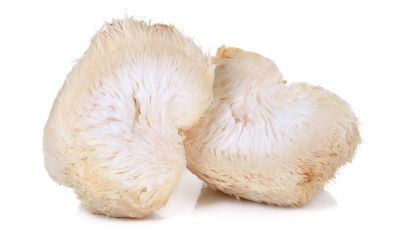 natural remedy for heartburn, reflux, gastritis and stomach ulcers. If it is used against chronic inflammatory bowel diseases, continuous intake is also recommended during symptom-free phases. Hericium also contains erinacins, which stimulate the nerve growth factor (NGF). As a result, stress symptoms such as restlessness, anxiety and sleep disorders decrease. This makes it a helpful natural remedy for irritable stomach, intestines and similar nervous complaints.
natural remedy for heartburn, reflux, gastritis and stomach ulcers. If it is used against chronic inflammatory bowel diseases, continuous intake is also recommended during symptom-free phases. Hericium also contains erinacins, which stimulate the nerve growth factor (NGF). As a result, stress symptoms such as restlessness, anxiety and sleep disorders decrease. This makes it a helpful natural remedy for irritable stomach, intestines and similar nervous complaints.
Finally, Hericium has also proven itself in the adjunctive treatment of cancer in the gastrointestinal tract.
Reishi
Very often Hericium is administered in combination with Reishi for gastrointestinal diseases. The two complement and support each other very well in their mode of action. Reishi has the following health-promoting properties:
- anti-allergic: This effect is also due to the triterpenes. They inhibit the release of histamine, which is often increased during stress and inflammation. Histamine in turn promotes allergic reactions, which can also affect the digestive tract.
- Anti-inflammatory:
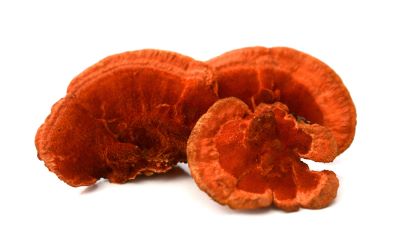 Finally, the triterpenes are also said to have anti-inflammatory properties. This makes reishi an effective natural remedy for heartburn, gastritis and diverticulitis.
Finally, the triterpenes are also said to have anti-inflammatory properties. This makes reishi an effective natural remedy for heartburn, gastritis and diverticulitis. - antioxidant: The antioxidants from the reishi bind free radicals that are produced in the course of inflammations and infections. Consequential damage is thus prevented.
- Immunomodulating: The beta-glucans of the reishi in particular strengthen the immune system, but also prevent excessive reactions.
- detoxifying, liver activating: the liver can be very stressed by the influx of intestinal toxins via the blood. the Reishi supports the liver in its function as the main metabolic organ and helps to better excrete the toxins.
- Relaxing: The adenosine from the reishi directly counteracts the neurotransmitter acetylcholine. It inhibits the transmission of the stimulus from the nerve to the muscle, which results in relaxed muscles. This effect is noticeable on a psychological level, which means that you feel calmer after taking Reishi. The vegetative balance in turn directly counteracts irritable stomach and intestines.
Finally, the ingredients of reishi promote the healing process of the gastric mucosa, for example after a stomach ulcer. They also have a prebiotic effect and inhibit the spread of fattening bacteria.
Cordyceps
Besides its anti-inflammatory effect,  the greatest significance of cordyceps with regard to diseases in the gastrointestinal tract is its potential to alleviate stress. On the one hand, this happens through the regulation of hormone production in the adrenal cortex. On the other hand, the amino acid L-tryptophan from cordyceps stimulates serotonin synthesis. Therefore, people feel more balanced and content when taking this vital mushroom regularly. Stress-related symptoms of the stomach and intestines become less likely.
the greatest significance of cordyceps with regard to diseases in the gastrointestinal tract is its potential to alleviate stress. On the one hand, this happens through the regulation of hormone production in the adrenal cortex. On the other hand, the amino acid L-tryptophan from cordyceps stimulates serotonin synthesis. Therefore, people feel more balanced and content when taking this vital mushroom regularly. Stress-related symptoms of the stomach and intestines become less likely.
Pleurotus
Pleurotus has a prebiotic effect. In particular, it supports the proliferation of lactobacilli, enterococci and bifidobacteria. A healthy intestinal environment automatically strengthens the body’s defences. In addition, Pleurotus has an anti-allergic and cholesterol-lowering effect. Both reduce the strain on the gastrointestinal tract.
Coprinus
Coprinus is thought to have digestive properties. It can help with constipation and prevents the formation of haemorrhoids. Its ingredients stabilise the blood sugar level, which can prevent cravings.
Coriolus
As a support of the immune system, 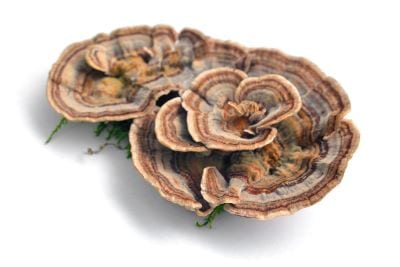 coriolus activates the TH1 immune response. This serves the targeted defence against bacteria, viruses and fungi. Typical troublemakers in the gastrointestinal tract are Candida and Helicobacter Pylori. Thanks to its antioxidant properties, it curbs the negative consequences of inflammations and infections. In addition, its use has been proven in gastrointestinal tumours and SIBO.
coriolus activates the TH1 immune response. This serves the targeted defence against bacteria, viruses and fungi. Typical troublemakers in the gastrointestinal tract are Candida and Helicobacter Pylori. Thanks to its antioxidant properties, it curbs the negative consequences of inflammations and infections. In addition, its use has been proven in gastrointestinal tumours and SIBO.
Maitake
Alternative medicine practitioners prefer to use maitake for diarrhoea. Here, the combination with reishi has proven successful. Since maitake also contains anti-inflammatory substances, it is an ideal medicinal mushroom for chronic inflammatory bowel diseases. Its prebiotic properties also serve as a treatment. By reducing the storage of triglycerides in the liver, it prevents fatty liver. Studies have shown that its intake also reduces the risk of polyps and cancer in the digestive tract. In practice, it has proven effective against bloating and flatulence.
Auricularia
This vital mushroom is known for its ability to moisten the mucous membranes. On the one hand, this promotes their natural protective barrier and on the other hand, it helps against constipation, which according to TCM is caused by dryness. It is recommended that those affected drink plenty of fluids and eat a lot of dietary fibre while taking Auricularia. Finally, the adenosine contained in Auricularia improves the general blood circulation in the body, which of course also benefits the digestive tract and its mucous membranes.
Chaga
In Russia, Finland and China, chaga is the classic medicinal mushroom for treating gastrointestinal disorders. It is …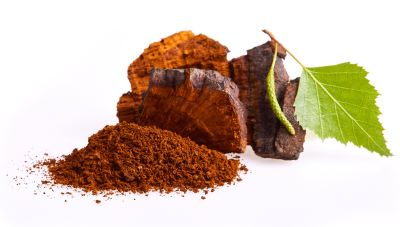
- antibacterial
- anti-inflammatory
- antioxidative
- antitumoral
- prebiotic
From these properties follows a general strengthening of the digestive tract, whereby in particular the risk of inflammation and ulcers is minimised. Likewise, the formation of tumours and metastases is less likely when taking Chaga. Its anti-inflammatory effect makes it a popular medicinal mushroom for complaints typical of gastritis.
Shiitake
Shiitake contains a very special polysaccharide: lentinan. Many studies show that the mushroom strengthens the body’s own defences through this and other beta-glucans it contains. It promotes the production of secretory immunoglobulin A (sIgA). With the help of this mucosa-protecting antibody, shiitake protects all mucous membranes in the body against attacks by viruses and bacteria. In addition, studies have shown an improvement in the intestinal flora after prolonged intake of shiitake powder.
Tips for taking vital mushrooms
We recommend that you always use powder from the whole mushroom. Only then can you be sure of all the valuable ingredients. Cultivation according to organic guidelines and a gentle drying process are the basis of a high-quality product. Although there are no side effects in the actual sense in connection with vital mushrooms, a gradual dosage is advisable. This way, the digestive tract can slowly get used to the dietary fibres contained in the mushroom powder. A general dosage cannot be determined. The type of vital mushroom and the dose must be determined depending on the person and the symptoms. For this, please contact our experts, who draw on their many years of experience and specialist knowledge.






